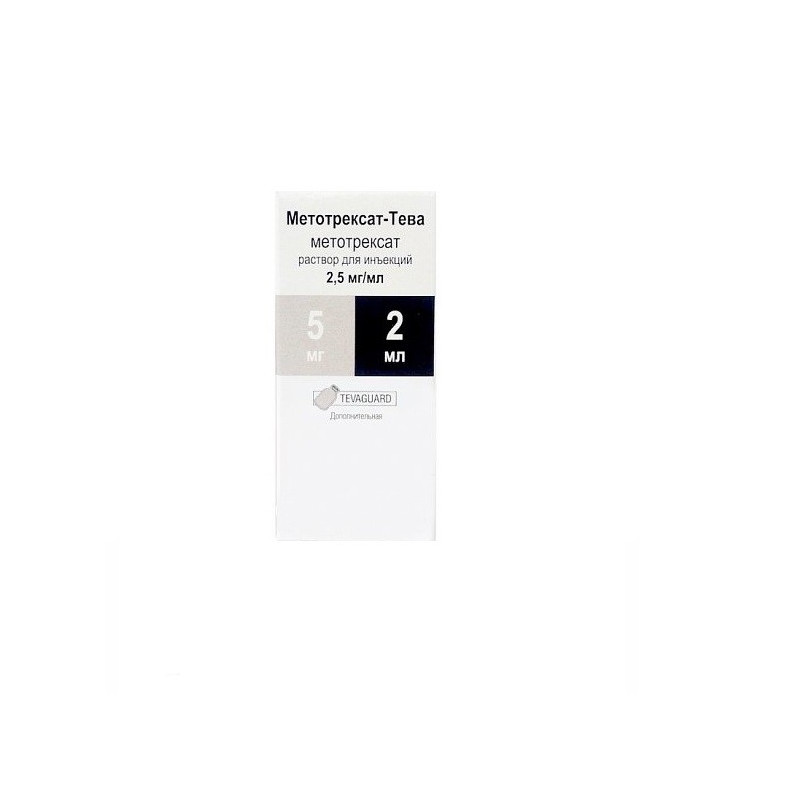



 All payments are encrypted via SSL
All payments are encrypted via SSL
 Full Refund if you haven't received your order
Full Refund if you haven't received your order
Antitumor agent from the group of antimetabolites - folic acid antagonists. Acts in the S-phase of mitosis. The mechanism of action is associated with the inhibition of the synthesis of purine nucleotides and thymidylate as a result of irreversible binding to dihydrofolate reductase, which prevents the recovery of dihydrofolate to active tetrahydrofolate. More active against fast growing cells. It has some immunosuppressive effects.
To a small extent penetrates through the BBB (depending on the dose used). When intrathecal injection in a significant amount enters the systemic circulation. Protein binding (mainly albumin) of plasma is about 50%. Biotransforming in the liver. Excreted by the kidneys (unchanged) and with bile (less than 10%). T1/2 depends on the applied dose and has significant individual differences. When reintroduced accumulates in the tissues in the form of metabolites.
Acute lymphocytic leukemia, trophoblastic disease, skin cancer, cervical and vulvar cancer, esophagus cancer, head and neck squamous cell carcinoma, renal pelvis and ureter cancer, osteogenic and soft cell sarcoma, Ewing's sarcoma, lung cancer, breast cancer, germ cell tumors of the testicle and ovarian, liver cancer, kidney cancer, retinoblastoma, medulloblastoma, penile cancer, lymphogranulomatosis.
Severe forms of psoriasis (in case of failure of standard therapy).
Severe rheumatoid arthritis (in case of failure of standard therapy).
Accept inside, enter into / in, in / m, intralyumbalno. They establish individually, depending on the evidence and the stage of the disease, the state of the hematopoietic system, the scheme of antitumor therapy.
Gastrointestinal: ulcerative stomatitis, anorexia, gingivitis, pharyngitis, nausea are possible; rarely - diarrhea, melena, enteritis, pancreatitis; in some cases (with prolonged daily use) - liver necrosis, cirrhosis, fatty atrophy, periportal fibrosis of the liver.
Hemic and lymphatic: leukopenia, anemia, thrombocytopenia.
From the side of the central nervous system: feeling tired, dizzy; rarely - headache, aphasia, drowsiness, cramps.
From the reproductive system: violations of oogenesis and spermatogenesis, oligospermia, menstrual disorders, decreased libido, impotence.
Urogenital: hematuria, cystitis, pronounced renal dysfunction.
Allergic reactions: chills, reduced resistance to infection; rarely - urticaria, toxic epidermal necrolysis, Stevens-Johnson syndrome.
Dermatologic: skin rash, photosensitivity, pigmentation disorders, telangiectasia, acne, furunculosis.
Severe disorders of the liver and / or kidneys, leukopenia, thrombocytopenia, pregnancy. Methotrexate should not be used in immunodeficiency states.
Methotrexate is contraindicated for use in pregnancy. If necessary, use during lactation should stop breastfeeding.
Women of childbearing age should use reliable methods of contraception during the use of methotrexate.
ATexperimental studies embryotoxic and teratogenic effects of methotrexate have been established.
Contraindicated in marked disorders of the liver.
Contraindicated in severe renal impairment.
Methotrexate should not be used for ascites, pleural effusion, gastric ulcer and duodenal ulcer, ulcerative colitis, gout or nephropathy (including in history).
It is not recommended for use in patients with chickenpox (including recently suffered or after contact with the sick), herpes zoster and other acute infectious diseases.
Before starting therapy and on the background of the treatment, a picture of peripheral blood, liver and kidney function, and chest X-ray should be monitored.
When treating rheumatoid arthritis or psoriasis, a complete complete blood count should be done at least once a month, and laboratory tests of liver or kidney function at least once every 1-2 months.
When applied for psoriasis, local treatment of the disease should not be interrupted. In case of overdose, the use of Calcium folinate is recommended (but no later than after 4 hours).
When conducting a combination of anticancer therapy, special care should be taken with the simultaneous use of methotrexate in high doses with drugs that have a nephrotoxic effect (for example, cisplatin).
Do not recommend vaccinating patients and their families.
Caution should be used to combine methotrexate (even in low doses) with Acetylsalicylic acid.
ATexperimental studies The carcinogenic and mutagenic effects of methotrexate have been established.
At simultaneous use with the vitamin preparations containing folic acid or its derivatives, decrease in efficiency of a methotrexate is possible.
The simultaneous use of NSAIDs in high doses can lead to an increase in plasma methotrexate concentration and to its lengthening T1/2, as well as an increase in the concentration of methotrexate, not associated with plasma albumin, which in turn enhances the toxic effects of methotrexate (primarily on the digestive tract and the blood-forming system).
With simultaneous use with penicillins, methotrexate (even in low doses) may increase its toxic effects.
With simultaneous use with sulfonamides, especially with co-trimoxazole, there is a risk of increased myelodepressive action.
With the use of nitrous oxide in patients receiving methotrexate, severe unpredictable myelodepression and stomatitis may develop.
With simultaneous use with methotrexate of valproic acid, it is possible to reduce its plasma concentration.
Kolestiramine binds to methotrexate, reduces its enterohepatic recirculation, which leads to a decrease in its concentration in the blood plasma.
With simultaneous use with mercaptopurine may increase its bioavailability due to metabolic disorders during the "first pass" through the liver.
Neomycin and paromomycin reduce the absorption of methotrexate from the gastrointestinal tract.
In patients receiving Omeprazole, may increase the concentration of methotrexate in the blood plasma.
With simultaneous use with probenecid, a 3-4-fold increase in plasma concentration of methotrexate is possible due to a decrease in its renal excretion.
The simultaneous use of methotrexate with retinoids may increase the risk of hepatotoxic action.
Salicylates potentiate the action of methotrexate due to a decrease in its renal excretion.
After a course of treatment with Tetracycline, methotrexate, used even in low doses, may have a toxic effect.
With the consistent introduction of methotrexate and Fluorouracil, synergism of action is possible; fluorouracil administered prior to methotrexate may reduce its toxicity.
Cisplatin has a nephrotoxic effect and therefore can reduce the renal excretion of methotrexate, which leads to an increase in its toxicity.
Possible increased toxicity with the use of cyclosporine in patients treated with methotrexate.
